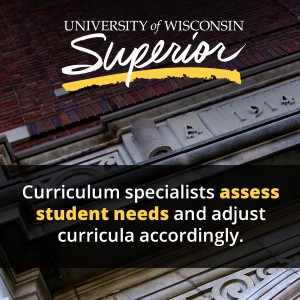
With the continued push toward the inclusion of students with special needs in the general education classroom, educators are constantly looking for ways to improve each student’s experience and learning. Although there are proven benefits of inclusion, traditional curricula and instructional techniques are not always optimal for students with cognitive, emotional or physical disabilities.
To positive effect, innovative educators have implemented adaptive technologies, various differentiated instruction methods and theory-based educational models such as the constructivist approach. Often, however, the curriculum needs adaptation as well in order to best meet the learning needs, goals and ability levels of special education students. In the University of Wisconsin Superior’s online Master of Science in Education in Special Education program, degree candidates will study and evaluate methods of curriculum adaptation and modification, along with strategies and instructional techniques, further integrating them in practice through clinical experience.
What Is Curriculum Adaptation?
Although the concept of curriculum adaptation is fairly straightforward, it can take many different forms. In essence, teachers and curriculum specialists adjust and modify curricula according to student needs and the goals set forth by that student’s Individualized Education Program (IEP). Educators and theorists use many different terms for varying types and degrees of curriculum adaptation, often with overlapping meanings. But most terms and definitions represent a similar spectrum of the magnitude of necessary adaptation.
Curriculum Modification and Curriculum Enhancement
In a paper from the National Center on Accessible Educational Materials entitled “Curriculum Modification,” authors Hall, Ge Vue, Koga and Silva suggest that the concept should break down broadly into curriculum modification and curriculum enhancement.
Enhancement is when teachers use existing curriculum in the general education classroom but adjust the methods and media of input and output to suit the student’s needs and IEP goals. Implementing differentiated instruction techniques, using adaptive technologies, changing the student’s physical environment, and integrating culturally responsive language and content into curriculum content are all examples of curriculum enhancement.
Curriculum modification implies a greater level of adjustment to the existing curriculum. In general, teachers often accomplish this by adjusting the depth or type of content within the existing curriculum. Perhaps a student whose learning disability prevents them from reading at the same rate or depth as other students needs more time to read the materials, a shorter piece to read, or an alternative piece covering the same content in simpler language. If a student has more severe cognitive disabilities, the teacher might further modify that student’s curriculum by changing their course material at a conceptual level. This is similar to altering reading materials to be simpler, but can also include changing the actual conceptual content of those materials towards different subjects more appropriate to that student’s cognitive abilities and goals.
Accommodation, Adaptation, Parallel Curriculum Outcomes and Overlapping Curricula
Hall, Ge Vue, Koga, and Silva also illustrate the concept of progressing levels of adapting curriculum for students with special needs into these four categories:
1. Accommodation:
Accommodation is this simplest form of adapting curriculum. It addresses students who are able to comprehend and perform at the regular curriculum’s levels of content and conceptual difficulty but require differentiation in instructional techniques and the medium in which each student demonstrates their depth of understanding.
2. Adaptation:
Adaptation is appropriate for students whose needs and learning goals are in line with the content of the regular curriculum but require a moderate modification of the depth of conceptual difficulty of that content.
3. Parallel Curriculum Outcomes:
Implementing parallel curriculum outcomes implies a greater modification of conceptual difficulty than adaptation. However, similar to adaptation, the content subject is the same, allowing that student to participate in classroom activities alongside other students. A teacher must address each student’s needs and IEP goals with adjusted learning outcomes and conceptual depth levels for each lesson.
4. Overlapping Curricula
Students who require heavily modified learning outcomes and goals may need integration into general classroom activities through overlapping curricula. In this situation, a student participates in classroom activities with individualized learning outcomes for each activity, including social/behavioral development goals, cognitive learning goals, language skills or even physical ability development.
Regardless of the terms and definitions, educators and theorists agree that the most effective way to adapt curricula in the inclusive classroom is truly individualized and student specific. Before modifying a curriculum, teachers should know each student’s learning goals and needs, assess their abilities, and implement the least intrusive form of curricular adaptation possible. By studying and implementing varying methods of adaptive instruction and curricular modification, special educators can develop the tools and techniques essential to creating effective, inclusive learning environments.
Learn more about the UW-Superior online MSE Special Education program.
Sources:
Tools for Teachers: Curriculum Modifications & Adaptations
ASCD: Memo to Constructivists: Skills Count, Too
ASCD: The Courage to Be a Constructivist
National Center on Accessible Educational Materials: Curriculum Modification


